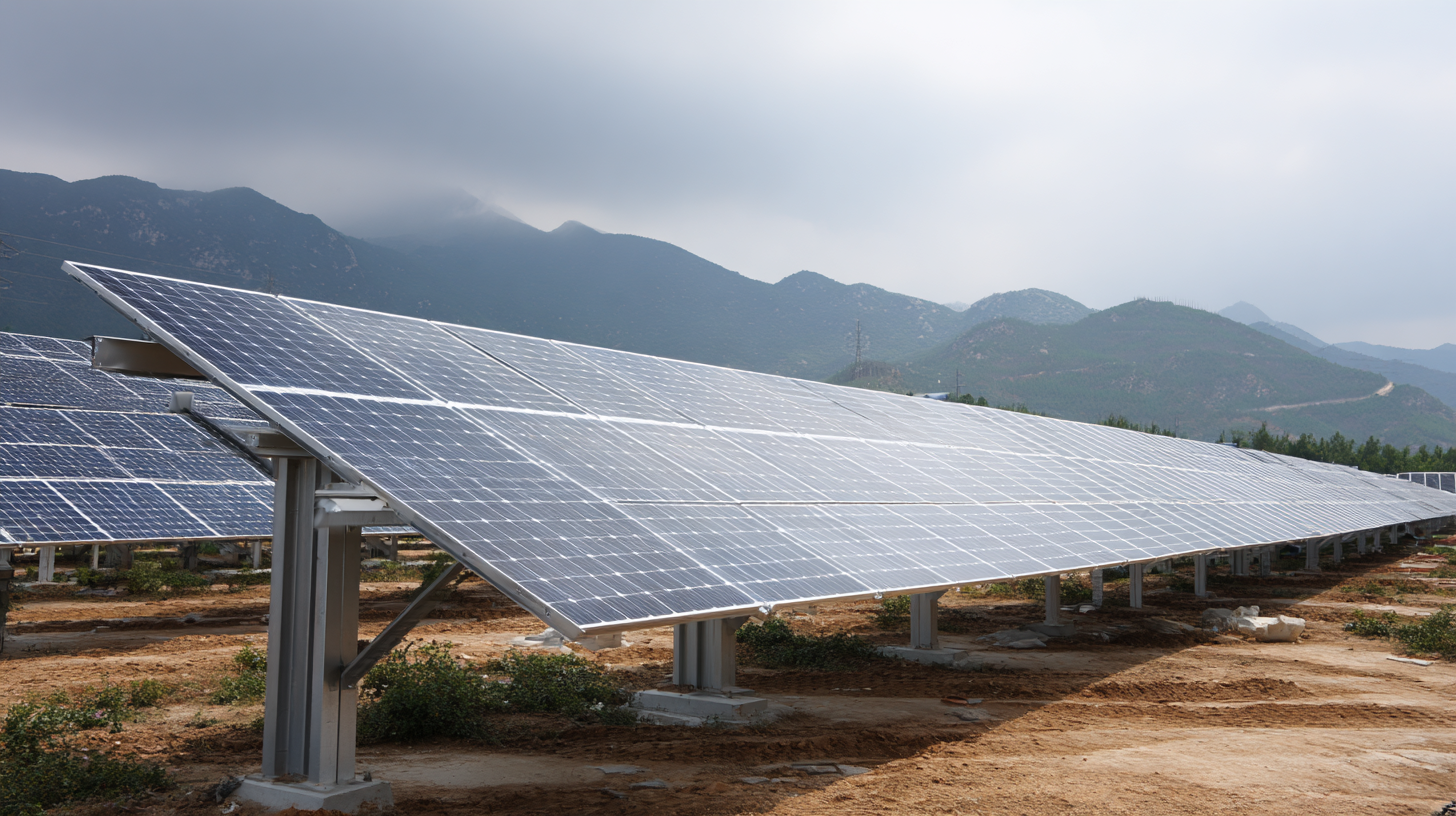
Blog
Setting Industry Standards for the Best Solar Energy Solutions: A Path to Sustainability
The global shift towards renewable energy sources has placed solar energy at the forefront of sustainable solutions, with an increasing number of countries adopting ambitious targets for solar capacity. According to the International Energy Agency (IEA), solar energy is projected to account for nearly 30% of the world's electricity generation by 2025, marking it as the fastest-growing source of power. However, despite its promise, the industry faces several challenges, including inconsistent standards and varying quality controls. A report from the National Renewable Energy Laboratory (NREL) indicates that these issues can lead to inefficiencies and decreased consumer confidence. Establishing industry standards for solar energy solutions is crucial not only for enhancing performance but also for ensuring the longevity and reliability of solar technologies.

In this blog, we will explore the current problems associated with these standards and outline a path to a more sustainable and robust solar energy future.
Understanding Solar Energy: Basics and Benefits
Solar energy is rapidly emerging as one of the most promising solutions to our global energy challenges. At its core, solar energy harnesses sunlight using technologies such as photovoltaic cells and solar thermal systems. This renewable energy resource is not only abundant, but also sustainable, providing an alternative to finite fossil fuels. By converting sunlight directly into electricity or heat, solar energy systems can significantly reduce greenhouse gas emissions, contributing to a cleaner environment.
The benefits of solar energy extend beyond environmental impacts. Economically, it presents cost-effective alternatives to traditional energy sources, often leading to lower utility bills for homeowners and businesses alike. Additionally, solar energy creates job opportunities in manufacturing, installation, and maintenance of solar technologies, thereby stimulating local economies. As awareness of these advantages grows, many are championing solar energy as a critical component in the transition to a sustainable future, highlighting the importance of understanding its basics to maximize its potential.
Setting Industry Standards for the Best Solar Energy Solutions: A Path to Sustainability
This chart illustrates key metrics for solar energy in 2023, showcasing the installed capacity, energy production, cost reduction percentage, and adoption rate, emphasizing the path toward sustainability.
Key Technologies Powering Solar Energy Solutions
Key technologies powering solar energy solutions are transforming the landscape of renewable energy. One of the most significant advancements is photovoltaic (PV) technology, which converts sunlight directly into electricity. Modern solar panels utilize high-efficiency materials, such as monocrystalline silicon, to maximize energy production while minimizing space usage. These enhancements not only improve the performance of solar systems but also make them more accessible for residential and commercial applications.
Another critical technology is solar thermal energy, which harnesses sunlight to generate heat. This method is particularly effective for heating water and is widely used in both residential and industrial settings. Innovations such as concentrating solar power (CSP) systems have further expanded the potential of solar thermal solutions, enabling large-scale energy production with the ability to store heat for later use. By complementing PV technology, these systems provide a more reliable and consistent energy supply, paving the way for a sustainable future powered by solar energy.
Setting Industry Standards for the Best Solar Energy Solutions: A Path to Sustainability - Key Technologies Powering Solar Energy Solutions
| Technology | Efficiency (%) | Lifespan (Years) | Cost per Watt ($) | Environmental Impact |
|---|---|---|---|---|
| Monocrystalline Silicon | 20-25 | 25 | 0.60-0.80 | Low |
| Polycrystalline Silicon | 15-20 | 25 | 0.50-0.70 | Moderate |
| Thin Film | 10-12 | 20 | 0.30-0.50 | High |
| Bifacial | 17-22 | 30 | 0.70-0.90 | Low |
| Building-Integrated Photovoltaics (BIPV) | 10-15 | 25 | 1.00-1.50 | Varies |
Establishing Industry Standards for Solar Energy Efficiency
Establishing industry standards for solar energy efficiency is crucial as the world shifts towards sustainable energy solutions. As we witness significant investments in renewable energy, such as Brazil's ambitious $100 billion decarbonization initiative, there is a compelling opportunity for countries to lead the global energy transition. These standards not only enhance the performance and reliability of solar technologies but also encourage innovation and competition within the industry, paving the way for substantial advancements in efficiency and output.
Countries like Germany, despite their less-than-ideal sun exposure, have set exemplary benchmarks by significantly increasing solar power outputs. This demonstrates that with the right policies and standards, solar energy can thrive in diverse conditions. Collaborative efforts, like those from the Energy Efficiency Resource Standards Workgroup, illustrate the importance of shared strategies and guidelines to drive energy efficiency and management. By focusing on the establishment of rigorous standards, stakeholders can ensure the long-term sustainability and effectiveness of solar energy solutions, ultimately leading to a cleaner and more efficient energy landscape.

Steps to Choose the Best Solar Energy System for Your Needs
When selecting the best solar energy system for your needs, it's essential to take a methodical approach. Start by assessing your energy consumption patterns. Understanding how much energy you use daily can help you determine the size and capacity of the solar system that will work best for you. This could include calculating your average monthly electricity bill and identifying the peak times of energy usage in your household.
Tip: To get a clearer picture of your energy needs, consider keeping an energy diary for a month. Track your daily usage and identify trends that can inform your solar system selection.
Next, examine the different types of solar technology available in the market, such as monocrystalline, polycrystalline, and thin-film solar panels. Each type varies in efficiency, cost, and aesthetics, which can influence your decision based on your budget and installation site. It's important to consult with reputable solar providers who can offer insights tailored to your specific requirements.
Tip: Don’t hesitate to ask for multiple quotes and system designs from different suppliers. This will give you a comparative landscape to make an informed decision while factoring in potential warranties and service options.
Future Trends in Solar Energy: Innovations and Sustainability
In 2023, the global solar refrigerator market reached a substantial size of $10.15 billion, reflecting the rising interest in innovative and sustainable energy solutions. As we look ahead, this market is projected to grow to $10.83 billion in 2024 and continue its upward trajectory, reaching $17.87 billion by 2031. This impressive growth rate of 7.42% CAGR highlights the increasing adoption of renewable energy technologies and the shift towards off-grid solutions.

Future trends in solar energy are heavily influenced by advancements in technology and a greater awareness of sustainability practices. Innovations in solar refrigerator designs, which integrate the latest advancements in photovoltaic systems and energy-efficient technologies, play a crucial role in reducing carbon footprints. As more consumers and businesses seek environmentally friendly alternatives, the demand for such innovative solutions is expected to soar, paving the way for a sustainable future. The ongoing evolution within the solar energy sector marks a significant step towards meeting global energy needs while preserving the environment for future generations.